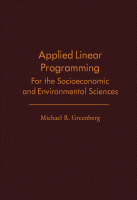Browse content
Table of contents
Actions for selected chapters
- Full text access
- Book chapterNo access
Index
Pages 323-327
About the book
Description
Applied Linear Programming for the Socioeconomic and Environmental Sciences discusses applications of linear and related programming to help in the transformation of the student or reader from book learning to computer use. The author reviews the theory, methods and applications of linear programming. The author also presents some programming codes that can be used in solving linear programming problems. He describes processes such as parametric programming, sensitivity analysis, and postoptimal analysis. The author lists five possible applications of linear programming, as follows: 1) estimates involving supply of and demand for services; 2) transport and schedule planning; 3) scale, technologies, and optimal site selection; (4) evaluation of impact of activates; and 5) evaluation of alternative options. The author cites a case study of solid-waste management in New Jersey that is common to other areas: availability of disposal sites, increasing amounts of garbage, and stricter environmental regulations. This book can be appreciated by environmentalist, sociologists, economists, civil engineers, and students and professors of advance mathematics and linear programming.
Applied Linear Programming for the Socioeconomic and Environmental Sciences discusses applications of linear and related programming to help in the transformation of the student or reader from book learning to computer use. The author reviews the theory, methods and applications of linear programming. The author also presents some programming codes that can be used in solving linear programming problems. He describes processes such as parametric programming, sensitivity analysis, and postoptimal analysis. The author lists five possible applications of linear programming, as follows: 1) estimates involving supply of and demand for services; 2) transport and schedule planning; 3) scale, technologies, and optimal site selection; (4) evaluation of impact of activates; and 5) evaluation of alternative options. The author cites a case study of solid-waste management in New Jersey that is common to other areas: availability of disposal sites, increasing amounts of garbage, and stricter environmental regulations. This book can be appreciated by environmentalist, sociologists, economists, civil engineers, and students and professors of advance mathematics and linear programming.
Details
ISBN
978-0-12-299650-4
Language
English
Published
1978
Copyright
Copyright © 1978 Elsevier Inc. All rights reserved.
Imprint
Academic Press
